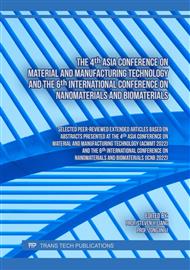[1]
I. K. Januariyasa and Y. Yusuf, "Porous carbonated hydroxyapatite-based scaffold using simple gas foaming method," Journal of Asian Ceramic Societies, vol. 8, no. 3, p.634–641, Jul. 2020.
DOI: 10.1080/21870764.2020.1770938
Google Scholar
[2]
A. Aminatun et al., "Biopolymer-based polycaprolactone-hydroxyapatite scaffolds for bone tissue engineering," International Journal of Polymeric Materials and Polymeric Biomaterials, 2021.
DOI: 10.1080/00914037.2021.2018315
Google Scholar
[3]
Y. Rizkayanti and Y. Yusuf, "Effect of Temperature on Synthesis of Hydroxyapatite from Cockle Shells (Anadara Granosa)," 2018.
Google Scholar
[4]
Almukarrama and Y. Yusuf, "Development Carbonated Hydroxyapatite Powders from Oyster Shells (Crassostrea gigas) by Sintering Time Controlling," in IOP Conference Series: Materials Science and Engineering, Jul. 2019, vol. 546, no. 4.
DOI: 10.1088/1757-899X/546/4/042001
Google Scholar
[5]
G. Cormick and J. M. Belizán, "Calcium intake and health," Nutrients, vol. 11, no. 7. MDPI AG, Jul. 01, 2019.
DOI: 10.3390/nu11071606
Google Scholar
[6]
P. Terzioğlu, H. Öğüt, and A. Kalemtaş, "Natural calcium phosphates from fish bones and their potential biomedical applications," Materials Science and Engineering C, vol. 91. Elsevier Ltd, p.899–911, Oct. 01, 2018.
DOI: 10.1016/j.msec.2018.06.010
Google Scholar
[7]
J. A. Currie, N. R. Harrison, L. Wang, M. I. Jones, and M. S. Brooks, "A preliminary study of processing seafood shells for eutrophication control," Asia-Pacific Journal of Chemical Engineering, vol. 2, no. 5, p.460–467, Sep. 2007.
DOI: 10.1002/apj.82
Google Scholar
[8]
V. K. Mishra, S. K. Srivastava, B. P. Asthana, and D. Kumar, "Structural and Spectroscopic Studies of Hydroxyapatite Nanorods Formed via Microwave-Assisted Synthesis Route," Journal of the American Ceramic Society, vol. 95, no. 9, p.2709–2715, Sep. 2012.
DOI: 10.1111/j.1551-2916.2012.05134.x
Google Scholar
[9]
N. Suwannasingha, A. Kantavong, S. Tunkijjanukij, C. Aenglong, H. B. Liu, and W. Klaypradit, "Effect of calcination temperature on structure and characteristics of calcium oxide powder derived from marine shell waste," Journal of Saudi Chemical Society, vol. 26, no. 2, Mar. 2022.
DOI: 10.1016/j.jscs.2022.101441
Google Scholar
[10]
M. Sari, P. Hening, Chotimah, I. D. Ana, and Y. Yusuf, "Porous structure of bioceramics carbonated hydroxyapatite-based honeycomb scaffold for bone tissue engineering," Materials Today Communications, vol. 26, Mar. 2021.
DOI: 10.1016/j.mtcomm.2021.102135
Google Scholar
[11]
M. Sari and Y. Yusuf, "Synthesis and characterization of hydroxyapatite based on green mussel shells (perna viridis) with the variation of stirring time using the precipitation method," in IOP Conference Series: Materials Science and Engineering, Nov. 2018, vol. 432, no. 1.
DOI: 10.1088/1757-899X/432/1/012046
Google Scholar
[12]
S. Soisuwan, J. Phommachant, W. Wisaijorn, and P. Praserthdam, "The Characteristics of Green Calcium Oxide Derived from Aquatic Materials," Procedia Chemistry, vol. 9, p.53–61, 2014.
DOI: 10.1016/j.proche.2014.05.007
Google Scholar
[13]
B. N. Bhattacharjee, V. K. Mishra, S. B. Rai, O. Parkash, and D. Kumar, "Structure of Apatite Nanoparticles Derived from Marine Animal (Crab) Shells: An Environment-Friendly and Cost-Effective Novel Approach to Recycle Seafood Waste," ACS Omega, vol. 4, no. 7, p.12753–12758, Jul. 2019.
DOI: 10.1021/acsomega.9b00134
Google Scholar
[14]
S. Rujitanapanich, P. Kumpapan, and P. Wanjanoi, "Synthesis of hydroxyapatite from oyster shell via precipitation," in Energy Procedia, 2014, vol. 56, no. C, p.112–117.
DOI: 10.1016/j.egypro.2014.07.138
Google Scholar
[15]
J. H. Shariffuddin, M. I. Jones, and D. A. Patterson, "Greener photocatalysts: Hydroxyapatite derived from waste mussel shells for the photocatalytic degradation of a model azo dye wastewater," Chemical Engineering Research and Design, vol. 91, no. 9, p.1693–1704, Sep. 2013.
DOI: 10.1016/j.cherd.2013.04.018
Google Scholar
[16]
M. Sari, P. Hening, Chotimah, I. D. Ana, and Y. Yusuf, "Bioceramic hydroxyapatite-based scaffold with a porous structure using honeycomb as a natural polymeric Porogen for bone tissue engineering," Biomaterials Research, vol. 25, no. 1, Dec. 2021.
DOI: 10.1186/s40824-021-00203-z
Google Scholar
[17]
H. A. Permatasari and Y. Yusuf, "Characteristics of Carbonated Hydroxyapatite Based on Abalone Mussel Shells (Halioitis asinina) Synthesized by Precipitation Method with Aging Time Variations," in IOP Conference Series: Materials Science and Engineering, Jul. 2019, vol. 546, no. 4.
DOI: 10.1088/1757-899X/546/4/042031
Google Scholar
[18]
M. Sari and Y. Yusuf, "Synthesis and Characterization of Hydroxyapatite based on Green Mussel Shells (Perna viridis) with Calcination Temperature Variation Using the Precipitation Method," 2018.
DOI: 10.1088/1757-899x/432/1/012046
Google Scholar



